|
14 December 2011 Author: Giorgos Lazaridis Hack a Hg Lamp to a Powerful UV Light Source
 | IMPORTANT
DANGEROUS CHEMICALS AND GASES!
DO NOT INHALE! Use safety mask suitable for dangerous gases. DO NOT GET IN CONTACT! Use SAFETY GLOVES and SAFETY GOOGLES. Make sure that you have taken all the appropriate precautions to AVOID ANY SKIN OR EYE CONTACT. Interacting with dangerous chemicals leads to severe health problems. |
|
 | IMPORTANT
UV RADIATION!
An overexposure to UVB radiation can cause skin burn, indirect DNA damage and some forms of skin cancer. Avoid direct exposure to UV. NEVER look directly to UV for this could lead to permanent eye problems. |
|
I got myself some UV-curable solder mask for my PCB workshop, and as soon as i got it, i discovered that my UV artwork transfer box is totally incapable to activate the UV paint and cure it. I began searching the net for powerful UV lamps, and then it hit me: Some months ago i uploaded a theory regarding the Cold and Hot cathode discharge lamps. During my research for these lamps i found out that they can provide directly visible light (lamps without internal coating), or they produce UV radiation. The lamps that produce UV radiation have an extra coating on their internal surface which glows when excited by the UV rays, thus producing light!
And then i went into the lab
And then i went into the lab, because i remembered that i had a mercury gas discharge lamp somewhere there... Moreover, this lamp had an internal coating, most likely it was fluorescent. Near the metallic part of the lamp, the glass had no coating and i could see inside:
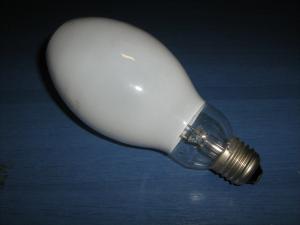 |
 |
 |
| This is the victim: Mercury vapor gas discharge |
Its a Philips 125 Watts |
From the bottom side i could see inside |
I need more UV - Break the glass!
I ran a quick test with this lamp to see the results. I was rather disappointed because after 10 minutes of exposure, the paint was still wet. Why? It is obviously: The lamp coating is there to glow from the UV, but also to block the radiation.
When i took a closer look inside, i discovered that inside the lamp, there was another "lamp". I took a wild guess: This internal lamp is the one that produces the UV light, and the external lamp has only the coating. There was only one way to find out if my speculation was correct: The hammer way...
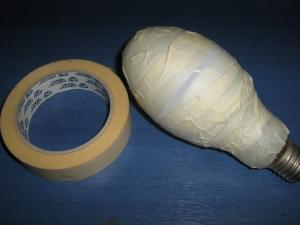 |
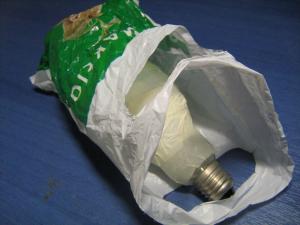 |
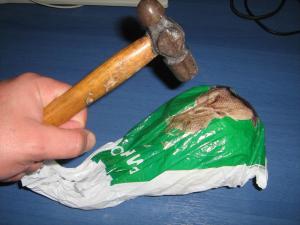 |
| I covered the lamp with paper-tape to avoid the mess from the broken glasses |
I placed the lamp into a bag... |
...and the hammer did the rest. I tried to be as gently as possible. |
This is what i got out of the plastic bag:
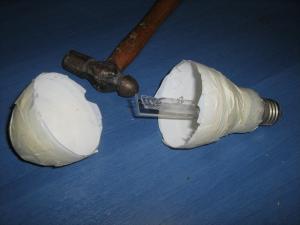
Then gently, i broke the glass near the metallic piece to remove it:
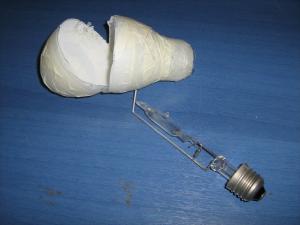
Does it work?
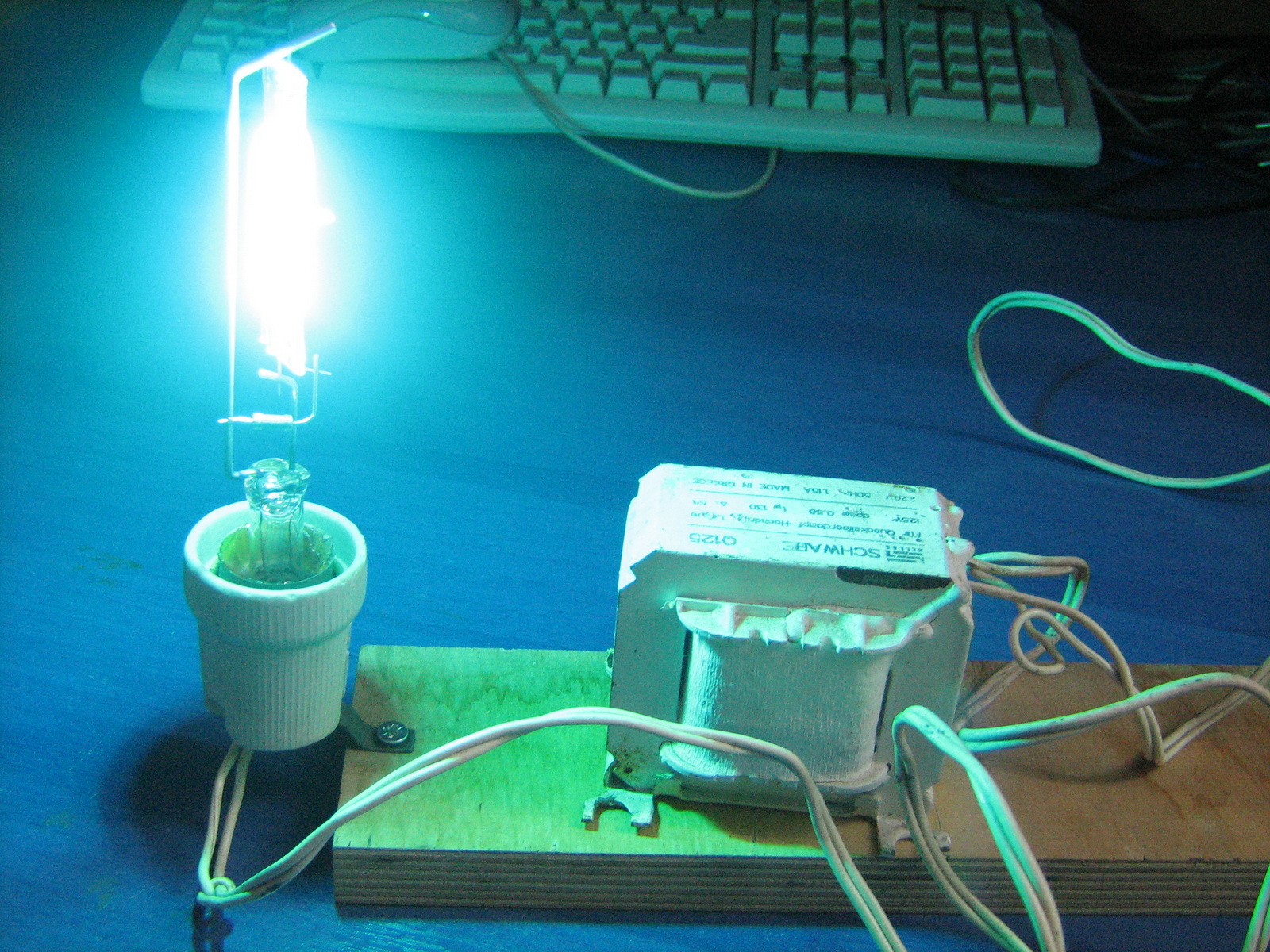
It looks like UV to me! I mean, the lamp originally had a very bright cold white light. Now that i removed the cover, the lamp glows a dark violet color. I only had to re-try cure the UV paint and see the results. So, here are the results: Before i break the glass, with 10 minutes of exposure from a distance of about 30cm, the paint did not cure at all. With the glass removed, from a distance of about 10cm, after 10 minutes of exposure, the paint cured completely. As a matter of fact, the board was overexposured under UV and some paint was cured even under the mask. The difference is obvious. This means 2 thing:
1: By removing the glass, the UV radiation is radically increased
2: I have to find out what consequences will have the broken glass on the lifespan of this bulb.
Comments
At 6 March 2012, 10:24:37 user Giorgos Lazaridis wrote: [reply @ Giorgos Lazaridis]@Chris C the voltage i use for this lamp is 220 through a ballast. thanks for your notes ;)
At 4 March 2012, 15:45:48 user Chris C wrote: [reply @ Chris C]It should be noted that when a MV lamp (as well as the more modern MH lamp) fails, the interior bulb can "pop" with enough force to crack and even shatter the exterior bulb. An "open rated" version is manufactured, but I suspect that its construction would further obscure UV radiation.
With that being said, this is a super cool use for these lamps. Would you mind sharing the voltage used and what size capacitor (if any, I didn't see one pictured) you used?
At 30 January 2012, 17:07:54 user Giorgos Lazaridis wrote: [reply @ Giorgos Lazaridis]@Pault Exactly. That is why i added this "dangerous radiation" sign. UV RADIATION
At 30 January 2012, 11:47:29 user Pault wrote: [reply @ Pault]Be careful of Ultraviolet light
from wikipedia
http://en.wikipedia.org/wiki/Mercury-vapor_lamp#Ultraviolet_hazards
All mercury vapor lamps (including metal halide lamps) must contain a feature (or be installed in a fixture that contains a feature) that prevents ultraviolet radiation from escaping. Usually, the borosilicate glass outer bulb of the lamp performs this function but special care must be taken if the lamp is installed in a situation where this outer envelope can become damaged.
Sun burns and eye inflammation have resulted
At 24 January 2012, 18:34:20 user Alexander Zhevak wrote: [reply @ Alexander Zhevak]That's OK.
Thirty years ago we used these lamps for cleaning the EPROM memory chips 2732 and 27256.
I don't believe it was in 1985... as to would be as yesterday or the past week. Ye-eh!
At 24 January 2012, 14:50:27 user Harley Pebley wrote: [reply @ Harley Pebley]Thanks for the reply. Just as I suspected. Thanks for the confirmation.
Cheers.
At 24 January 2012, 5:47:59 user Kammenos wrote: [reply @ Kammenos]@Harley Pebley The Hg vapor is in the inside glass protection wich you are not supposed to break. What i noticed when i broke the outside glass is that air was sucked in, so the outside protection was under sub-pressure. There are though phosphoric particles in the white powder that you do not want to breathe.
At 24 January 2012, 0:48:12 user Harley Pebley wrote: [reply @ Harley Pebley]Thanks for this. I need a source of UV for a project I'm working on, unrelated to PCB manufacturing.
Is there any dangerous materials in the outside glass envelope that's being broken here? (I imagine the Hg vapor is in the inner one.)
A tip for breaking light bulbs, I've found both channel lock pliers or adjustable locking pliers work well. You can adjust them so their smallest closed position is just less than the glass and squeeze (in a plastic bag like you've shown). Because they won't close smaller than what you've preset, they won't crush the filament inside. Also, I've found it easiest to break the glass just above the metal base where the glass is narrowest; there's more mechanical leverage there with the pliers.
Cheers.
At 16 December 2011, 14:31:25 user Fung wrote: [reply @ Fung]Is it possible to show a video for us to view? |
|
 HOT in heaven! HOT in heaven!

|
|

 Home
Home
 Projects
Projects
 Experiments
Experiments
 Circuits
Circuits
 Theory
Theory
 BLOG
BLOG
 PIC Tutorials
PIC Tutorials
 Time for Science
Time for Science



 Contact
Contact
 Forum
Forum
 Projects
Projects
 Experiments
Experiments
 Circuits
Circuits
 Theory
Theory
 BLOG
BLOG
 PIC Tutorials
PIC Tutorials
 Time for Science
Time for Science
 RSS
RSS